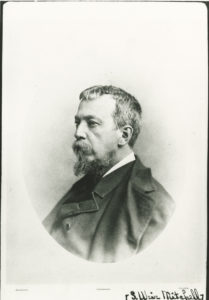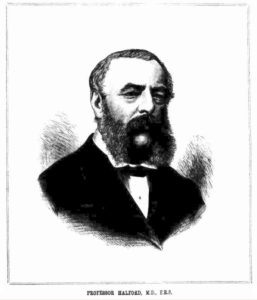– by Dr. Peter Hobbins*
The title of ‘world’s deadliest snake’ has long been contested, and remains difficult to adjudicate. The criteria are varied, including: 1) the annual human death toll; 2) the innate toxicity of the venom for laboratory animals; 3) the rarity of the serpent, and 4) whether it is a shy or aggressive species. The clinical impact of bites, whether leading to rapid death from respiratory paralysis, awful and extensive ulceration, or permanent disability, tends to be a lower-level consideration – except, naturally, for those who have been bitten.
Until the 1860s, however, it was unclear whether there was any meaningful difference between the venoms of poisonous snakes around the world. Indeed, for centuries it had been presumed that they all possessed the same ubiquitous ‘venom’. The potency of their bites was instead believed to depend largely upon environmental factors, such as the ambient temperature, and especially by the malevolence of the serpent itself. “The cause of the Venom is to be imputed to the Spirits enraged”, wrote French apothecary Moyse Charas in 1670, “and not to any other thing or parts in the Vipers body”.
Thus although it was understood that not all serpents were deadly, and conversely that some were more fearsome than others, venom itself rarely came under scrutiny. In the seventeenth century, Florentine physician-naturalist Francesco Redi had studied the venom of vipers via hundreds of animal experiments, followed in the eighteenth century by Felice Fontana at the University of Pisa, whose sacrificed creatures numbered in the thousands. His authority was so absolute that, as Philadelphia physician Silas Weir Mitchell wrote in 1860, since “the days of Fontana … no researches of any moment had added to our knowledge of the poison of serpents”.
Yet Mitchell himself soon became the nineteenth century’s heir to Fontana. As an experimental physiologist, his landmark monograph, Researches Upon the Venom of the Rattlesnake, established him as the world’s foremost authority on snake venom. Publishing this treatise just prior to the Civil War, he returned to his serpentine subject matter in 1868, largely in response to a profusion of snakebite ‘antidotes’ being touted in the medical literature upon very scanty evidence.
One item that caught Mitchell’s eye was a note published in 1867 in the British Medical Journal, hailing from the University of Melbourne, capital city of the Colony of Victoria, one of the British possessions in Australia. Based upon observations of a fatal bite by an imported Indian cobra, this article compared the appearance of the blood of humans and dogs after admixture with cobra or Australian snake venoms. Its author, British-trained George Halford, was Melbourne’s Professor of Anatomy, Physiology and Pathology – indeed, at that time the only professor of medicine in the southern hemisphere.

What Halford believed he saw in the blood of animal and human victims was the formation of a hybrid population, with the victims’ cells being overwhelmed by reptilian ‘germinal matter’ in the venom. These invading cells were considered living beings themselves, draining the ‘animal power’ from the unfortunate host and thus leading to their untimely demise. In the early days of Louis Pasteur’s germ theory of disease, such a prospect was far from ludicrous.
Mitchell, however, could detect no such ‘germinal matter’ in the blood of any of the many animals he had poisoned with rattlesnake venom. In February 1868, he therefore sent a note to Halford in Melbourne, along with a small pill box. “Desirous to offer you a chance of fairly comparing results I enclose a small amount of dried Rattlesnake venoms which you will find efficient”, he wrote. “Can you not send me specimens in like manner of your own serpents?” Sadly, Mitchell sought in vain. Eighteen years later, he wrote “all efforts on our part to obtain the venoms of Australian and South American snakes have failed”.
Halford, nevertheless, had been busy. Upon receiving Mitchell’s venom samples, he used them in a series of critical experiments. The first, in which he injected the re-hydrated rattlesnake venom into a dog, formed the first trial for his new idea for a snakebite remedy: the intravenous injection of ammonia. From 1868 until 1876, this antidote grew in popularity in the Australian colonies, being declared ‘wondrous’ and ‘magical’ by doctors and laypersons alike. Derided by his opponents as a poison and “trifling with human life”, Halford’s idea was eventually discredited by both local studies and especially a trial of his remedy in British India.
In the meantime, however, Halford had also used his windfall from Mitchell to conduct the first studies anywhere in the world that compared the venoms of the American rattlesnake, Indian cobra and Australian tiger snake. He made two startling claims. The first was that venoms differed in their fundamental nature: while the rattlesnake’s poison caused pronounced damage to the tissues near the injection site, Australian and Indian venoms were largely free from such local effects. Secondly, he claimed in October 1868, the tiger snake was “as deadly as, or even more so than”, the two species that had previously vied for the dubious honour of the world’s most deadly serpent.
What this gambit created was a serpentine arms race, in which investigators such as Mitchell in Philadelphia, Joseph Fayrer in Calcutta and, later, Albert Calmette in Saigon sought to define whose snakes were the most deadly. These comparisons led Mitchell to admit that there was no longer such a singular entity as snake ‘venom’; henceforth it was understood that each species of snake also produced its own ‘species’ of venom.
Concurrently, an acrimonious dispute opened between British doctors in Australia and India, which in 1874 saw Australian black and tiger snakes arriving in Calcutta to be tested against cobras. The results of these studies – which convincingly discredited Halford’s ammonia injection – came out in favour of the cobra. Nevertheless, further studies through to the end of the nineteenth century saw the margin narrow, until eventually Australian snakes were declared to possess the most potent of venoms. Their human death toll, however, paled in contrast to the estimated 5000 Indians who died each year from cobra bite.
By the 1880s, the titles of new monographs illustrated the shift in thinking toward venoms in the plural, including Alfred Wall’s Indian Snake Venoms (1883) and Mitchell and Edward Reichert’s Researches Upon the Venoms of Poisonous Serpents (1886). These works, in turn, proved critical to the development of specific antivenenes (antivenoms) – commencing with an experimental serum targeted to treating rattlesnake bites in 1887.
In the end, what Mitchell’s gift to Halford had inspired was a recognition of the vast diversity of venoms as entities in their own right, independent of the local environment or the ‘enraged’ spirits of the snake as it bit. If they did not comprise ‘germs’ in Halford’s sense, these venomous exchanges certainly planted the germ of an idea that radically shifted the understanding and treatment of snakebite thereafter.
*Dr. Peter Hobbins is a historian at the University of Sydney, Australia. His first book, Venomous Encounters: Snakes, Vivisection and Scientific Medicine in Colonial Australia, will be published by Manchester University Press in 2016.



I am surprised that you consider George Halford, the only professor of medicine in the southern hemisphere. What about all the universities in Latin America? As an example, the Spaniards founded the University of Mexico in 1551 and it included in its staff, a chair of medicine, with 150 gold pesos every year from May 13 1578. The first professor was Juan de la Fuente (c. 1530-1595) born in Mallorca and graduated from the universities of Sigüenza and Seville.
Thanks for your comment, Jose. You are right, that I am not aware of any professors of medicine in Latin America prior to the 1860s, so perhaps I should have limited my comment to “the only professor of medicine in the antipodes” (which means Australia and New Zealand). Mexico City, though, is very much in the northern hemisphere.
Dear Peter. You are of course completely right. I just wanted to emphasize that the universities founded by the Spaniards in America from the XVI Century onwards included usually Medicine chairs but my example was a mistake. In order to improve the comment, a better example would be the University of San Marcos (Lima. Perú), one of the two that claim to be the first in America (Santo Domingo is the other), where 4 chairs of Medicine were established in the XVI-XVIII centuries:
Prima: created and funded in 1571. The first chairman was Juan de la Vega (physician of the Count of Chinchon)
Vísperas. The first chairman was Dr. Jerónimo Andrés Rocha.
Método de Arte y Curativo de Galeno: created in 1660. The first chairman was Francisco Vargas Machuca.
Anatomy: created in 1711.
Now, my turn for corrections. Antipodes is a concept that depends on your location. As far as I know the antipodes of the United States is a large mass of water in the Indic Ocean, except for two islands that are mostly inhabited. New Zealand is a wonderful country and, in addition, the antipodes from Spain!
By the way, nice post!